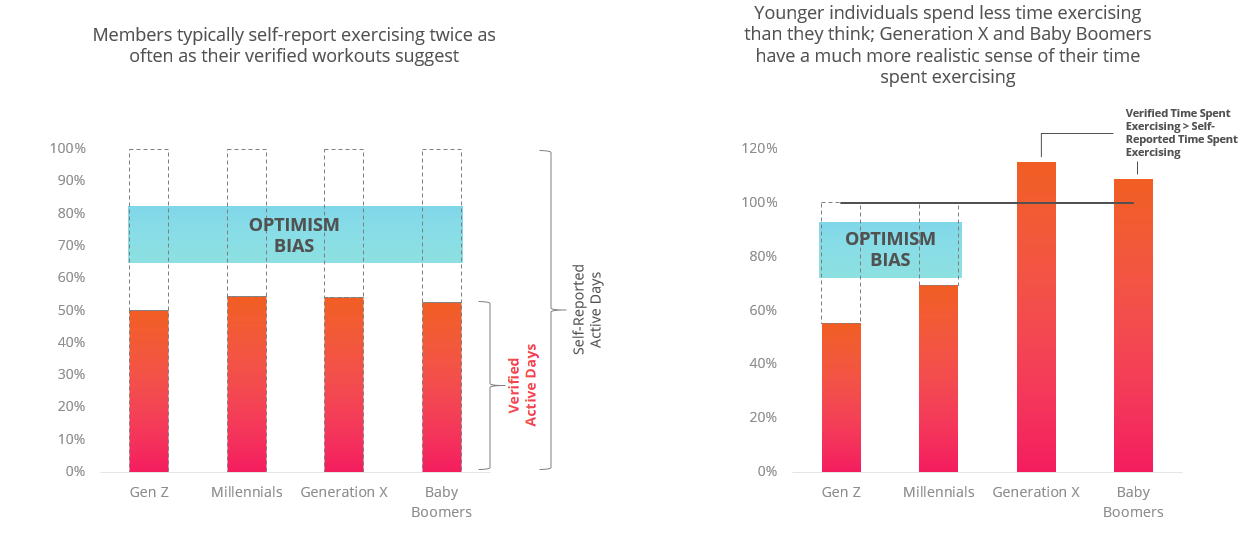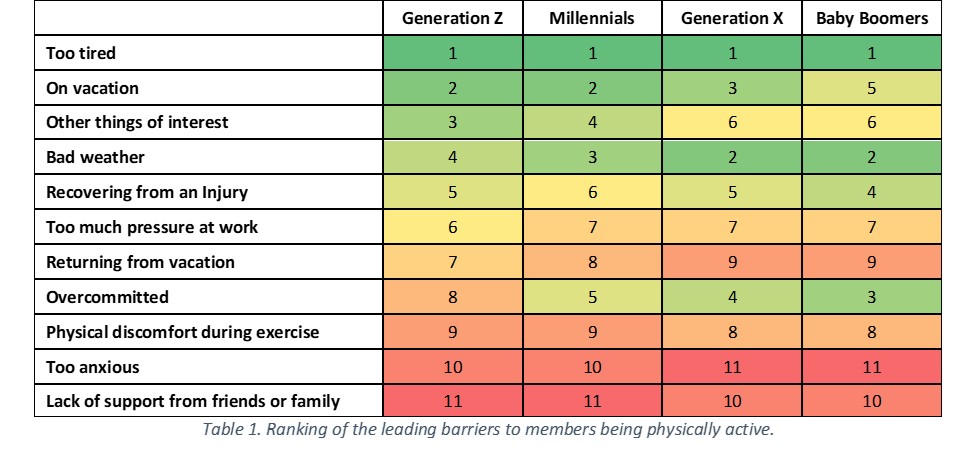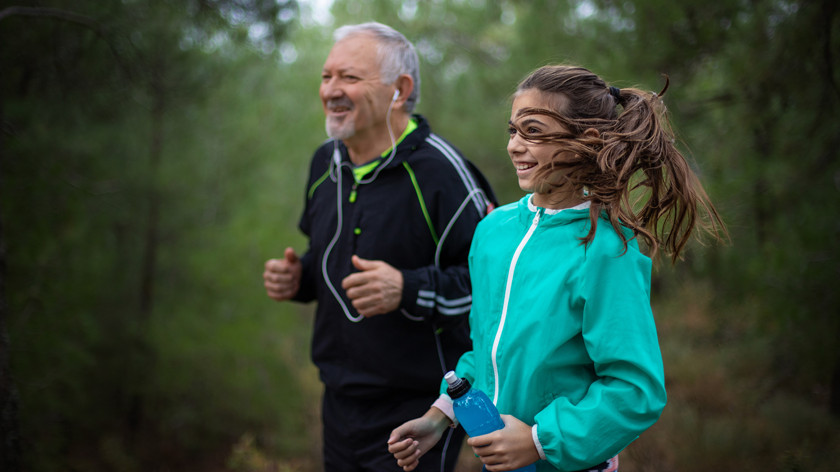From Generation Z to Baby Boomers and beyond, we all have one thing in common this time of year: we’re all thinking about our New Year’s resolutions. With almost 40% of New Year’s resolutions related to improving overall health [1], one might think that our perspectives on exercise are as diverse as the people who have it on their 2020 to-do list. While the generations may not agree on everything, our approaches to and views on physical activity are remarkably similar according to our analysis of more than 350,000 members. Not only does this empower us with a roadmap for maintaining our already good behaviors, but it also points toward consistent missteps that we might all benefit from improving.
Overestimating Exercise: Begin at the Beginning
Across generations, most people prefer doing aerobic activity and strength training to individual and team sports, and this preference increases with age. But regardless of our preferred mode of exercise, we need to make sure that we are being realistic about how much we exercise today so that we may chart a realistic pathway forward. As numerous studies as well as Vitality’s data illustrate, we all tend to suffer from an optimism bias in which we overestimate our actual levels of exercise [2]. In fact, we found that in our over-optimism, we overestimate our number of weekly workouts by a factor of two consistently across generations. However, on days when we do exercise, Generation X and Baby Boomers not only spend up to 80% more time exercising, but typically have a more accurate sense of their time spent exercising compared to their younger peers.

Figure 1. The chart on the left indicates workout sessions per week; the chart on the right indicates minutes spent exercising per week,.
Making Exercise Social Helps Sustain Motivation Throughout the Year
Across generations, our members consistently report their enjoyment of making exercise social by being active with friends. Going to a group fitness class, going for a walk with a friend, or joining a sports league are all great ways to be active and social at the same time, while also staying motivated by the presence of accountability partners. Studies have shown that people are more motivated to stick with an exercise program and have better aerobic exercise performance when they work out with a partner [3] [4]. If you can’t work out with a friend in person, there is an array of helpful apps at your fingertips to keep you motivated and on track.
Looking for Added Motivation? There Is Nothing Better Than the Great Outdoors
With the exception of Generation Z, most people prefer to exercise outdoors. With the winter’s freezing temperatures and snowy conditions, it’s essential to plan well if you are going to exercise outdoors. But if bundling up to go for an outdoor jog doesn’t appeal to you, try checking out a new gym class, using an indoor bike trainer, or swimming laps at an indoor pool to mix up your indoor routine.
Place Exercise on Your Calendar to Route Out Excuses
Across the generations, people cite being too tired to exercise as the greatest barrier to being active (Table 1). However, did you know that exercising can actually help increase your energy levels? To combat fatigue getting in the way of your workout, make sure you are staying hydrated, eating a diet of nutrient-dense foods and getting enough sleep. One method of combating exhaustion at the end of the day is to schedule your workout on your calendar like you would an appointment or a meeting. Across the generations, people tend to be spontaneous with their workouts rather than planning them carefully on their calendars. By carving out time for your workouts – and according to a recent RAND study, most of us do in fact have time to spare [5] – you are more likely to follow through on your commitment to be active [6] [7].
 No matter what your preferred method of physical activity is – whether you like to workout with friends or exercise solo, choose to stay indoors or brave the cold weather, or prefer your activity is spontaneous or planned – it’s important to make living an active and healthy lifestyle a priority as we head into a new year and a new decade. And we’ll be here cheering you on for your progress on your health journey.
No matter what your preferred method of physical activity is – whether you like to workout with friends or exercise solo, choose to stay indoors or brave the cold weather, or prefer your activity is spontaneous or planned – it’s important to make living an active and healthy lifestyle a priority as we head into a new year and a new decade. And we’ll be here cheering you on for your progress on your health journey.
References
|
[1] |
NPR/PBS NewsHour, “The Marist Poll,” 2019. |
|
[2] |
A. Kapteyn, J. Banks, M. Hamer, J. P. Smith, A. Steptoe, A. van Soest, A. Koster and S. H. Wah, “What they say and what they do: comparing physical activity across the USA, England and the Netherlands,” Journal of Epidemiology & Community Health, vol. 72, no. 6, pp. 471-476, 2018. |
|
[3] |
R. R. Wing and R. W. Jeffery, “Benefits of recruiting participants with friends and increasing social support for weight loss and maintenance,” Journal of Consulting and Clinical Pscyhology, vol. 67, no. 1, pp. 132-138, 1999. |
|
[4] |
B. C. Irwin, J. M. Scorniaenchi, N. L. Kerr, J. C. Eisenmann and D. L. Feltz, “Aerobic exercise is promoted when individual performance affects the group: A test of the Kohler Motivation Gain Effect,” Annals of Behavioral Medicine, vol. 44, pp. 151-159, 2012. |
|
[5] |
R. Sturm and D. A. Cohen, “Free Time and Physical Activity Among Americans 15 Years or Older: Cross-Sectional Analysis of the American Time Use Survey,” Preventing Chronic Disease, vol. 16, 2019. |
|
[6] |
U. Scholz, B. Schuz, J. P. Ziegelmann, S. Lippke and R. Schwarzer, “Beyond behavioural intentions: Planning mediates between intentions and physical activity,” British Journal of Health Psychology, vol. 13, no. 3, pp. 479-494, 2010. |
|
[7] |
S. Lippke, J. P. Ziegelmann and R. Schwarzer, “Initiation and Maintenance of Physical Exercise: Stage-Specific Effects of a Planning Intervention,” Research in Sports Medicine, vol. 12, no. 3, pp. 221-240, 2004. |
Lianne Jacobs, Product Analyst, has a master’s degree in public health from Yale University. She is the only indoor cycling instructor who can’t ride a bike. She enjoys traveling the world, laughing at her own jokes, and tricking her husband into eating baked goods made with hidden vegetables.
Matthew Shancer, Senior Data Analyst, has a master’s degree from the University of Illinois at Urbana-Champaign where he focused on utilizing advertising to encourage physical activity and healthy eating.






